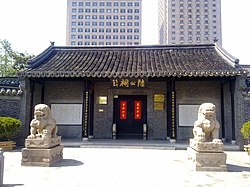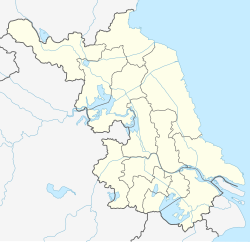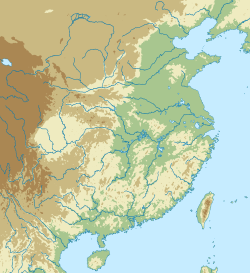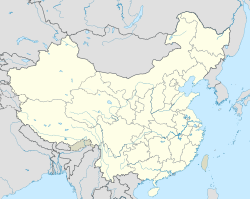Yancheng
Yancheng
盐城市 Yencheng | |
|---|---|
 Yancheng | |
 | |
 Yancheng is highlighted on this map | |
| Coordinates (Yancheng municipal government): 33°20′54″N 120°09′45″E / 33.3482°N 120.1626°E | |
| Country | People's Republic of China |
| Province | Jiangsu |
| Government | |
| • Type | Prefecture-level city |
| • CPC Yancheng Secretary | Zhu Kejiang (朱克江) |
| • Mayor | Dai Yuan (戴源) |
| Area | |
| • Prefecture-level city | 16,920.83 km2 (6,533.17 sq mi) |
| • Urban | 1,914 km2 (739 sq mi) |
| Population (2018 Census) | |
| • Prefecture-level city | 7,200,000 |
| • Density | 430/km2 (1,100/sq mi) |
| • Urban | 1,615,717 |
| • Metro | 1,615,717 |
| Time zone | UTC+8 (China Standard) |
| Postal code | 224000 (Urban center) 224100-224700 (Other areas) |
| Area code | 515 |
| ISO 3166 code | CN-JS-09 |
| GDP | ¥548.7 billion / US$79.77 billion (2018) |
| GDP per capita | ¥75,986 / US$11,047 (2018) |
| Major Nationalities | Han |
| County-level divisions | 9 |
| Township-level divisions | 144 |
| License Plate Prefix | 苏J |
| Website | www |
| Yancheng | |||||||||||||||
|---|---|---|---|---|---|---|---|---|---|---|---|---|---|---|---|
| Simplified Chinese | 盐城 | ||||||||||||||
| Traditional Chinese | 鹽城 | ||||||||||||||
| Hanyu Pinyin | Yánchéng | ||||||||||||||
| Literal meaning | Salt City | ||||||||||||||
| |||||||||||||||
Yancheng (Chinese: 盐城; pinyin: Yánchéng) is a prefecture-level city in northeastern Jiangsu province, People's Republic of China. As the city with the largest jurisdictional area in Jiangsu, Yancheng borders Lianyungang to the north, Huai'an to the west, Yangzhou and Taizhou to the southwest, Nantong to the south, and the Yellow Sea to the east.
Yancheng, literally "Salt City", is named after the salt harvest fields surrounding the city. According to historical records,[which?] collection and production of sea salt in the region began as early as 119 BC, during the Western Han Dynasty, when the settlement on the current location of Yancheng was named Yandu County (盐渎县). According to the 2010 Census, Yancheng has a registered population of 8,203,728 — with 7,260,240 permanent residents.[1] Its built up area of Tinghu and Yandu Districts was home to 1,615,717 inhabitants in 2010.
Administration
The prefecture-level city of Yancheng administers 9 county-level divisions, including 3 districts, 1 county-level city and 5 counties. The population information here presented uses 2010 census data of permanent residents.
| Map | |||||
|---|---|---|---|---|---|
| Subdivision | Simplified Chinese | Hanyu Pinyin | Population (2010) | Area (km2) | Density (/km2) |
| City Proper | |||||
| Tinghu District | 亭湖区 | Tínghú Qū | 904,417 | 1,072.25 | 843.48 |
| Yandu District | 盐都区 | Yándū Qū | 711,300 | 1,050.32 | 677.22 |
| Suburban | |||||
| Dafeng District | 大丰区 | Dàfēng Qū | 707,069 | 3,008.08 | 235.06 |
| Rural | |||||
| Xiangshui County | 响水县 | Xiǎngshuǐ Xiàn | 509,524 | 1,473.80 | 345.72 |
| Binhai County | 滨海县 | Bīnhǎi Xiàn | 956,162 | 1,949.60 | 490.44 |
| Funing County | 阜宁县 | Fùníng Xiàn | 843,275 | 1,438.78 | 586.10 |
| Sheyang County | 射阳县 | Shèyáng Xiàn | 896,639 | 2,605.72 | 344.10 |
| Jianhu County | 建湖县 | Jiànhú Xiàn | 741,646 | 1,157.07 | 640.97 |
| Satellite cities (County-level cities) | |||||
| Dongtai City | 东台市 | Dōngtái Shì | 990,208 | 3,175.67 | 311.81 |
| Total | 7,260,240 | 16,931.29 | 428.80 | ||
History
Yancheng has a history of 2,100 years since the first canton was founded here in Han Dynasty at year 119 BC. It was named for the salt reserves in rivers around the area, its name literally meaning "Salt City". In later years, the city was the home of Fan Zhongyan, the 12th century statesman and Shi Nai'an, the reputed author of famous novels.[2]
Yancheng was in the limelight during the Chinese Civil War from the 1930s to 1940s. The New Fourth Army led by the Communist Party of China was reestablished in Yancheng after being ambushed and battered by the enemy. After the revival, the Army played a very important role in the war and finally the foundation of the People's Republic of China. Many monuments in honor of these heroes can still be found around Yancheng.[2]
Chenjiagang Chemical Industry Park explosions
A major fire and explosion accident happened in March 2019, killing 78 people and at least 94 were severely injured. Around 640 people required hospital treatment and were taken to 16 hospitals. The facility—located in Yancheng's industrial park—was operated by Tianjiayi Chemical (江苏天嘉宜化工有限公司), and was used to produce fertilizer[3] or pesticides.[4] Tianjiayi Chemical had previously been penalized six times for infractions of pollution and waste management laws,[5] and China Daily reported fines over safety issues. According to the South China Morning Post, this plant paid bribes, paid journalists and local officials so this chemical plant could remain open without any negative publicity or reasons to shut down.[6]
On 27 November 2007, an explosion occurred in one of the chemical factories in Chenjiagang Chemical Zone (陈家港生态化工园区), with seven killed and around 50 injured.[7][8]On 23 November 2010, more than thirty were poisoned by a toxic gas release.[9][10] In the early morning of 11 February 2011, rumors of toxic chemical release and potential imminent explosions in the Chenjiagang Chemical Industry Park led over ten thousand residents to evacuate in panic from the towns of Chenjiagang and Shuanggang (双港镇) during which four people died and many were injured.[9] On the afternoon of May 18 and again on July 26 in 2011, there were explosions at local factories.[11]
Geography


Yancheng occupies roughly 582 km (362 mi) of coastline, more than half of the whole province. By the end of the Mesolithic period, the marine transgressions changed almost of the area into a shallow bay. Continued deposition of silt carried by the Yangtze River and the Huai River extend its coast to the east gradually. Since 1128, the course of the Yellow River have changed to join up with the Huai River. The change has accelerated.
Climate
Typical of northern and central Jiangsu, Yancheng has a humid subtropical climate (Köppen Cfa/Cwa), strong influenced by the East Asian Monsoon. The normal monthly mean temperature ranges from 1.7 °C (35.1 °F) in January to 26.9 °C (80.4 °F) in July, with the annual mean at 14.68 °C (58.4 °F).[12] A majority of the mean annual precipitation of 1,002 mm (39.4 in) is distributed in June thru August.[12]
| Climate data for Yancheng (1981–2010 normals) | |||||||||||||
|---|---|---|---|---|---|---|---|---|---|---|---|---|---|
| Month | Jan | Feb | Mar | Apr | May | Jun | Jul | Aug | Sep | Oct | Nov | Dec | Year |
| Mean daily maximum °C (°F) | 6.1 (43.0) |
8.2 (46.8) |
12.7 (54.9) |
19.2 (66.6) |
24.9 (76.8) |
28.2 (82.8) |
30.8 (87.4) |
30.4 (86.7) |
26.8 (80.2) |
22.1 (71.8) |
15.4 (59.7) |
8.8 (47.8) |
19.5 (67.0) |
| Daily mean °C (°F) | 1.7 (35.1) |
3.5 (38.3) |
7.6 (45.7) |
13.6 (56.5) |
19.3 (66.7) |
23.4 (74.1) |
26.9 (80.4) |
26.5 (79.7) |
22.4 (72.3) |
16.9 (62.4) |
10.3 (50.5) |
4.0 (39.2) |
14.7 (58.4) |
| Mean daily minimum °C (°F) | −1.7 (28.9) |
−0.1 (31.8) |
3.6 (38.5) |
8.8 (47.8) |
14.6 (58.3) |
19.6 (67.3) |
23.8 (74.8) |
23.4 (74.1) |
18.9 (66.0) |
12.9 (55.2) |
6.3 (43.3) |
0.4 (32.7) |
10.9 (51.6) |
| Average precipitation mm (inches) | 30.4 (1.20) |
34.2 (1.35) |
53.6 (2.11) |
52.1 (2.05) |
77.7 (3.06) |
121.2 (4.77) |
228.7 (9.00) |
172.9 (6.81) |
106.4 (4.19) |
50.1 (1.97) |
50.3 (1.98) |
24.1 (0.95) |
1,001.7 (39.44) |
| Average relative humidity (%) | 73 | 74 | 74 | 75 | 76 | 79 | 85 | 86 | 81 | 76 | 75 | 72 | 77 |
| Source: China Meteorological Administration[12] | |||||||||||||
Transportation
Road
Expressways
- G15 Shenyang–Haikou Expressway
- G1515 Yancheng–Jingjiang Expressway
- G1516 Yancheng–Luoyang Expressway
National Highway
Railway
Xinyi-Changxing Railway runs through the city.
Buses
The BRT system of Yancheng uses a dedicated bus lane on a 16 km (9.9 mi) route and as of 2010 carries 33,000 passengers per day. The first line went into service in 2010.[13]
The Yancheng District SRT Line 1 began testing in March 2021 and officially opened for trial operation on 16 April 2021 with a 17-station, 13 km (8.1 mi) route. The line uses the Autonomous Rail Rapid Transit system with four-segment 320 passenger guided vehicles. During the trial operation, the B3 line of Yancheng City Public Transport Company will run on the same line as the SRT.[14][15]
Air
Yancheng Nanyang International Airport now flies directly to Shanghai and Beijing, as well as flying directly to Hong Kong, Taiwan, South Korea, Japan and so on.
Economy
The economy of Yancheng City has sustained its momentum. Preliminary statistics found that in 2015 gross regional products of the city was RMB 421,250,000,000, a 10.5 percent increase by comparable price from previous year. Agriculture has increased by RMB 51,653,000,000 in value, a 3.6 percent increase from previous year; industry has increased by RMB 192,547,000,000 in value, a 10.5 percent increase from previous year; tertiary business has increased by RMB 177,050,000,000 in value, a 12.5 percent increase from previous year.
Gross regional products per capita was RMB 58,299 (or USD 8,862 at the average exchange rate of 2015), a 10.4 percent increase from previous year.
Education
Universities and colleges
- Yancheng Institute of Technology
- Yancheng Teachers University
High schools
- Jiangsu Yancheng Middle School
- Jiangsu Yancheng Jingshan Middle School
- Tinghu High School of Jiangsu Province
- Jiangsu Funing Middle School
- Jiangsu Yancheng NO.1 Middle school
Tourism
Outdoor activities include the Yangcheng wetlands and salt marshes, home of some unique and endangered species, including Père David's deer and the red-crowned crane. There is also a famous food street in east road springing up in recent years in which there are many restaurants in the style of Huizhou architecture.
Notable people
- Lu Xiufu
- Qiao Guanhua
- Hu Qiaomu
- Hau Pei-tsun
- Taylor Wang
- Wei Yi
- Luo Xiaojuan
- Xu Sihai – purple tea pot expert and curator[16]
Twin cities
Yancheng is twinned with the following domestic and foreign cities.
Domestic
- Turpan, Xinjiang
- Taiyuan, Shanxi
- Yanbei Prefecture, Shanxi
- Qinzhou, Guangxi
- Wuxi, Jiangsu
- Xicheng District, Beijing
- Zhuhai, Guangdong
- Qinhuangdao, Hebei
- Jilin, Jilin
- Yan'an, Shaanxi
- Yangjia, Shanxi
- Haikou, Hainan
- Dachuan, Sichuan
- Changning District, Shanghai
- Lhasa, Tibet
- Dandong, Liaoning
- Xuhui District, Shanghai
International
 Chieti, Abruzzo, Italy (since October 1, 1992)
Chieti, Abruzzo, Italy (since October 1, 1992) Namwon, North Jeolla, South Korea (June 13, 1998)
Namwon, North Jeolla, South Korea (June 13, 1998) Deva, Romania (November 12, 1998)
Deva, Romania (November 12, 1998) Kashima, Ibaraki, Japan (November 8, 2002)
Kashima, Ibaraki, Japan (November 8, 2002) San Diego, California, United States (October 20, 2003)
San Diego, California, United States (October 20, 2003)
Formal paper to be signed
- Hagen, Germany
- St. Petersburg, Russia
- Brescia, Italy
In addition, the county-level city of Dafeng, administered by Yancheng, is also twinned with Ascoli Piceno, Italy (September 2001) and Guri, South Korea (February 20, 2003) respectively.
References
- ^ (in Chinese) Compilation by LianXin website. Data from the Sixth National Population Census of the People's Republic of China
- ^ a b "Yancheng Introduction (Yancheng Middle School)".
- ^ "Death Toll Soars to 44 in China Chemical Plant Blast, At least 90 Injured". News18. 2019-03-22. Retrieved 2019-03-22.
- ^ "Dozens killed and hundreds injured in explosion at Chinese chemical plant". The Guardian. 22 March 2019. Retrieved 23 March 2019.
- ^ "China chemical blast death toll rises to 47". BBC News. 22 March 2019. Retrieved 22 March 2019.
- ^ "Chinese industrial park where chemical factory blast happened 'opened in a rush'". South China Morning Post. 31 March 2019.
- ^ 江苏省响水县一化工厂发生爆炸事故 已致7人死亡. Government of the People's Republic of China. 28 November 2007. Archived from the original on 3 August 2012.
- ^ Liu, Zhaoquan (刘兆权); Deng, Huaning (邓华宁) (30 November 2007). 响水"1127"爆炸事故原因初步查明. CCTV. Archived from the original on 2019-03-22.
- ^ a b 江苏响水因谣言引发上万人惊慌出逃 [Rumors in Xiangshui, Jiangsu Lead over 10,000 to Evacuate in Panic]. Sina Corp. 29 March 2011.
2月9日深夜到10日凌晨,在江苏响水县上演的"大逃亡闹剧"最终导致4人死亡、多人受伤,而事发全程不过六七个小时。{...}晚上10点半左右,他突然发现厂区内冒起了白烟,随之而来的是一股比平时更加刺鼻的气味。"不好,又出事了。"刘洪昌顿时紧张起来。他家所在的大湾村与化工园区仅隔一条马路。2010年11月,园区一家企业发生氯气泄漏,30多名工人中毒。2007年,化工园区还发生过一次伤亡达50人的爆炸,村民们当时感觉"像发生了地震"。感觉"出事"的刘洪昌随即给几个正在一起打牌的朋友打电话,提醒他们:又有氯气泄漏了,"赶紧往上风的方向跑"。随后,牌局立刻中止,大家迫不及待地将这一"可怕的消息"通知家人、亲友。{...}2月10日凌晨2点左右,响水大逃亡达到高潮。据响水县人民政府办公室副主任、新闻发言人周厚良介绍,当日加入逃亡大军的人涉及陈家港镇、双港镇等4个乡镇的30多个行政村,超过一万人。
- ^ Zhu, Xudong (朱旭东); Wang, Junyong (王骏勇) (12 January 2011). 一则“谣言”引发“万人出逃”的背后——江苏响水“化工厂爆炸传言”事件追踪 (in Simplified Chinese). Archived from the original on 22 March 2019.
- ^ Gao, Shan (高山) (27 July 2011). 盐城南方化工有限公司日前再次发生爆炸. Radio Free Asia. Archived from the original on 22 March 2019.
5月18日下午,陈家港的南方化工厂果然发生重大火灾。7月26号该厂又再次发生爆炸。
- ^ a b c 中国气象数据网 - WeatherBk Data (in Chinese (China)). China Meteorological Administration. Retrieved 2020-04-21.
- ^ "Yangcheng CORRIDOR Indicators - Line 1". Retrieved 20 July 2021.
- ^ "国内首条超级虚拟轨道交通线在盐城"热身"测试". people.cn. 20 March 2021. Retrieved 20 July 2021.
- ^ "全国首条超级虚拟轨道列车来啦!盐城市区SRT一号线16日开通试运行". XHBY. 15 April 2021. Retrieved 20 July 2021.
- ^ Tong, Qian (2020-06-30). "Purple clay teapot expert dies at age of 74". SHINE. Archived from the original on 2020-07-02. Retrieved 2020-07-10.
External links
- Government website of Yancheng (available in Chinese and English)
- Yancheng Local portal (in Simplified Chinese)
- Yancheng comprehensive guide with open directory (Jiangsu.NET)
- Yancheng Tourism Board (in Simplified Chinese)
- Yancheng Introduction (Yancheng Middle School) Extensive background on Yancheng history.




